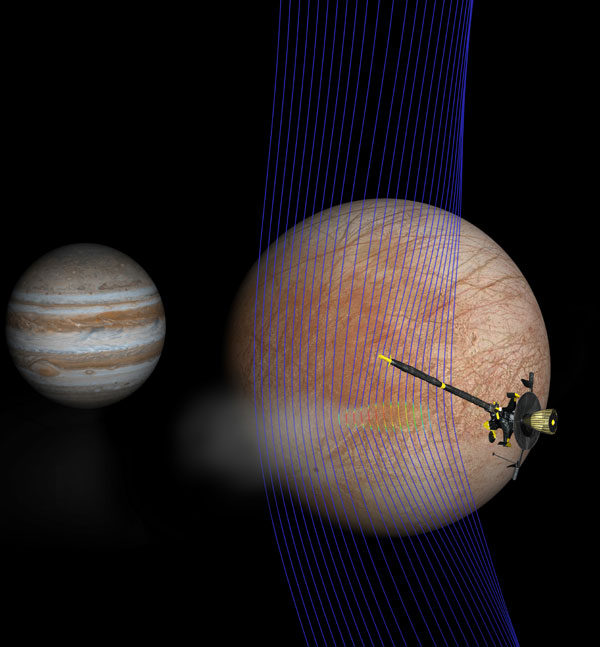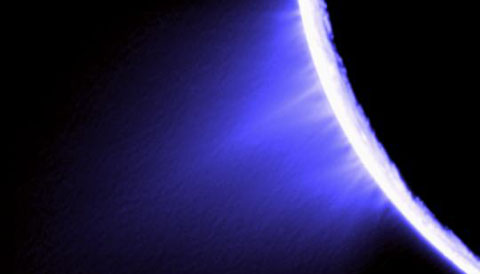
NASA / JPL-Caltech / Univ. of Michigan
Ocean worlds abound in the outer solar system and, it seems, so do plumes. A new analysis of decades-old data from NASA’s Galileo spacecraft, which reached the Jupiter system in 1995, shows the best evidence yet for plumes from the icy moon Europa.
Now it’s easier than ever to confuse Europa with its much smaller cousin, Enceladus. The 504-km- (313-mile-) wide Enceladus is an icy moon orbiting Saturn, and in 2015 Cassini witnessed water vapor flying from its surface in hundred-kilometer-high plumes. Meanwhile over the past decade Hubble has spotted several hints of plumes vented from the 3,122-km-wide Europa, one of Jupiter’s Galilean moons. The data matched a “heat anomaly” observed from the same region in later Galileo data; still, the evidence wasn’t definitive.
Inspired by Hubble’s tantalizing images, Xianzhe Jia (University of Michigan) and colleagues turned back to data collected by the Galileo probe some 20 years ago. They realized that the region where Hubble had seen repeated evidence of plumes was near one of the regions that Galileo had flown by — Galileo might have flown right through a plume without anyone realizing it.
Galileo had made a total of 11 close flybys of Europa, but only two came close enough to have a chance at detecting anything plume-like. It was the first of these that turned out to be the treasure chest. Galileo was flying within 400 km of the moon’s surface at 6 km/s (13,000 mph), traversing 1,000 km in just three minutes at its closest approach, when its magnetometer measured the magnetic field bending and then suddenly jumping in strength. Meanwhile, the probe’s Plasma Wave Spectrometer showed a dense concentration of charged particles that suddenly dropped away.

NASA / ESA / W. Sparks / USGS Astrogeology Science Center
But the real kicker was a sophisticated computer model known as a 3D multi-fluid magnetohydrodynamic simulation — code that didn’t exist yet when Galileo was first collecting its data. The team used what they already knew from Hubble observations about the potential plume’s size and density, then ran the simulation. To their delight, the simulated plume nicely reproduced the magnetic field and density changes that Galileo saw.
Galileo wouldn’t have seen much — the stream of particles was thin. But NASA scientists are hoping that the Europa Clipper mission, due to launch in the mid-2020s, will image the plumes directly by way of sunlight scattering off airborne particles.

NASA / JPL / Space Science Institute
“The plan for the Europa Clipper was to do as global a search for plumes as possible,” says Elizabeth Turtle (Johns Hopkins University Applied Physics Lab). “But this gives us a good place to start.”
Unlike Galileo, the Clipper will be coming much closer to the icy moon — some of its 44 passes will take it as close as 25 km to the surface.
The probe will carry mass spectrometers, to deduce the composition of Europa’s surface, subsurface ocean, and plumes, and — like Galileo — instruments to measure plasma density and magnetic fields. Unlike Galileo, the Clipper will also have visible and infrared imaging systems, an ultraviolet spectrograph, and ice-penetrating radar that will measure kilometers below Europa’s icy surface.
While the instruments are known, the trajectory isn’t, and these new results will help define how the Clipper will orbit Europa.
 2
2









Comments
Roger Venable
May 15, 2018 at 8:09 am
"Galileo, which didn't carry any cameras . . ." you say. That makes me think that Monica is indeed "Young," and didn't witness the wonderful, provocative, and scientifically productive images as they became available, as us older folks did. Galileo carried cameras. Its cameras failed to image the plumes that were detected by Hubble and now have been seen to fit the magnetohydrodynamic simulation. But thanks, Monica, for a great article.
You must be logged in to post a comment.
Monica YoungPost Author
May 15, 2018 at 10:45 am
Indeed, my mistake! I did look up Galileo's instruments and didn't see cameras listed, but that was my oversight. I've fixed the text - thanks!
You must be logged in to post a comment.
You must be logged in to post a comment.